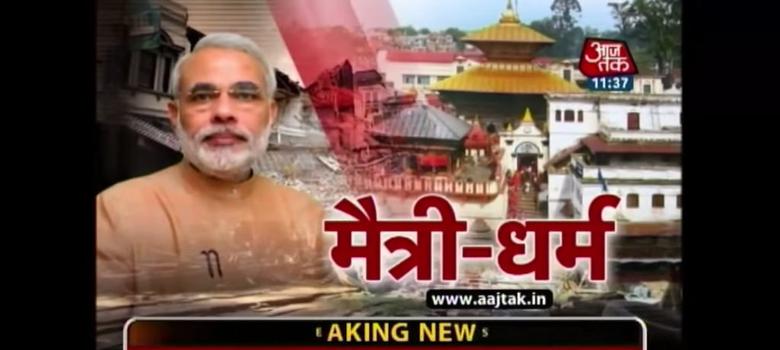SCROLL.IN, 04 May, 2015
Ranjona Banerji

Social media and TV news in India have turned Nepal’s tragedy into a display of self-aggrandisement.
Over the weekend, the hashtag #GoHomeIndianMedia was the top trend on Twitter. The message came from the people of Nepal, who were sick of the way the Indian media was covering the earthquake of April 25.
In many ways, this was an international relations disaster waiting to happen and was foreseen by many. Almost as soon as the Indian media heard of the earthquake, bad journalism began. It started on Saturday morning with many anchors finding it difficult to fathom that an earthquake cannot be covered like a cricket match or a film release. It needed a bit of serious thinking and planning. But true to form, it became a contest between two impulses: to say “India is the greatest” and “I’m a better channel than you”.
The Indian government was indeed prompt to respond to the plight of Nepal, a neighbour and a very old friend with a shared heritage. The Indian Armed Forces is experienced in relief and rescue operations. But having done that, Indian nationalism on social media and on TV news went into chest-thumping overdrive. The focus was on the enormity of the Indian rescue effort and the personal involvement of Indian Prime Minister Narendra Modi. The implication was twofold: India was doing everything and Nepal was incapable. Add to that shoddy and sensationalist reportage, especially on television, where grieving survivors and their families were asked how they felt about the deaths they had witnessed or had heard about. As one person pointed out, earthquake victims felt they were being treated like characters in an Indian soap opera.
Geopolitical battle
The Indian media also took huge umbrage to the fact that Pakistan had sent Nepal either beef or packets of beef masala as part of their aid package. It did not occur to any of our televangelists that it was up to Nepal to be offended or grateful. We just cornered the problem as our own, decided that Nepal was upset because it was a “Hindu nation”. This, in the eyes of many Nepalis, turned their tragedy into our geopolitical battle.
But it was on social media that the nationalistic triumphalism was on full display. The fact that India had helped Nepal now had several subtexts. India had helped because of Modi’s efficiency. India had never helped anyone before Modi was sworn in. No other nation was helping so generously ‒ unsaid but by implication. The Indian Armed Forces were the greatest and more in the same vein. The Indian prime minister did not help by saying that his Nepalese counterpart had learnt about the earthquake from Modi’s Twitter account (although he did say that India felt Nepal’s pain).
For a person of Nepali origin, watching the aftermath of the earthquake on Indian television, the message was clear: Nepal would be finished if it wasn’t for India and Modi. Many TV channels had the Indian prime minister permanently on their screens as a backdrop. The backlash therefore was strong, with almost 60,000 tweets, according to some reports, carrying the hashtag #GoHomeIndianMedia.
Big Brother attitude
The reaction to this phrase in India was even more intriguing. Those who had warned that Indian self-congratulation on the aid to Nepal was trumping India’s generosity felt justified ‒ even if they had been slammed, threatened and abused roundly on social media at the time. Initially, a few right-wing social media regulars felt quite happy at this shaming of the media ‒ which they often categorise as “paid” or “presstitutes” and agents of every party but the Bharatiya Janata Party.
However their satisfaction soon turned to rage. The criticism of the media was seen as a criticism of India itself, which is oddly amusing given how the media is usually abused. But it was soon evident that the #GoHomeIndianMedia demand elliptically referred to India’s aid effort as well. Nepal’s editorials pointed out that many of the Indian rescue efforts were aimed at getting Indians to safety. The Indian media rode on Armed Forces vehicles when that space could have been used to help the people of Nepal. The anger harked back to Nepal’s old and simmering discontent about India’s patronising “big brother” attitude in the neighbourhood.
The right-wing on Twitter – which had in no small measure contributed to making India seem like an ungracious bully – now turned on Twitter itself and the people of Nepal. Some users wondered how the people of Nepal, under siege, managed to find the time and the internet connections to tweet their anger. The head of Twitter India was offensively and aggressively interrogated about where the hashtag originated from. The conspiracy theorists of the right-wing had returned to the same old bogey: it was evil, anti-national paid media Congress agents who had started this trend to malign Modi and his hard work. Thus, they denied the people of Nepal even that inalienable right to be angry when they wanted to. If any of these worthies had bothered to read any of Nepal’s newspapers or websites, they might have got an inkling of the mood in that country.
So here we are. A wonderful opportunity for selfless help in keeping with our high image of ourselves lies shattered around us. Each little shard mocks us for our failed attempt at self-aggrandisement. A little generosity of spirit would have served us a bit better, perhaps.
Read more at: #GoHomeIndianMedia was an international relations disaster waiting to happen


